Introduction
Most businesses don’t have a lead generation problem, they have a funnel problem.
You can have the best offer, the sharpest ads, and traffic pouring in, but if your funnel leaks, every click costs you twice as much. Prospects don’t convert, they disappear.
A Lead Generation Funnel fixes that. It’s not a buzzword; it’s the engine behind every scalable online business. When built right, it captures attention, builds trust, and turns cold traffic into paying clients predictably.
In this guide, you’ll learn exactly how to build, optimize, and scale a lead generation funnel that actually converts step by step. You’ll see real examples, practical frameworks, and the same funnel strategies used by top marketers and agencies in 2025.
Whether you’re a coach, creator, or small business owner, by the end of this guide you’ll know how to build a funnel that attracts better leads, closes more deals, and never wastes a single visitor again.
Key Takeaways
What Most Funnels Miss (And What Yours Won’t)
- Where funnels silently lose 80% of conversions and how to stop the leak before your next campaign.
- The 3-stage system agencies use to turn cold traffic into booked calls with zero hard selling.
- Funnel assets that attract, nurture, and convert without chasing leads or discounting your offer.
- Metrics that expose what’s working and what’s wasting your budget.
- Templates pulled from battle-tested funnels not theory, not guesswork, just proven systems that scale.
Disclaimer: I am an independent Affiliate. The opinions expressed here are my own and are not official statements. If you follow a link and make a purchase, I may earn a commission.
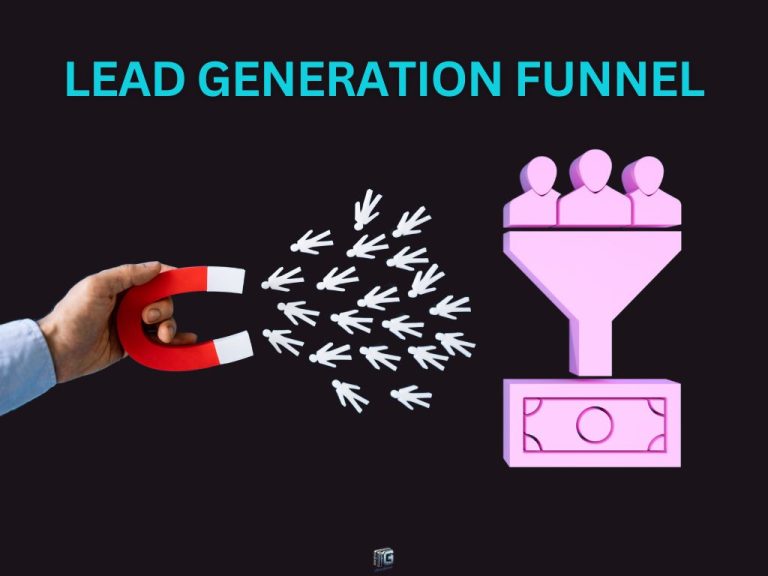
What Is a Lead Generation Funnel (Why Most Businesses Get It Wrong)
A Lead Generation Funnel isn’t just a landing page or an email sequence, it’s the complete path your audience follows from the first moment they discover your brand to the point they become paying clients.
It’s the structure that turns awareness into trust, and trust into consistent revenue.
At its core, every high-performing funnel moves through three connected stages:
- TOFU (Top of Funnel): Capture attention and spark curiosity.
- MOFU (Middle of Funnel): Nurture interest, provide value, and build credibility.
- BOFU (Bottom of Funnel): Present your offer and convert interest into action.
Where most businesses fail is in trying to sell too soon. They treat all leads the same, skipping the trust-building that makes conversions possible. The result? High traffic, low results.
A true lead generation funnel meets your audience where they are addressing problems before pitching solutions. It guides prospects naturally toward a decision, not through pressure but through clarity and value.
When built correctly, your funnel becomes more than a marketing system. It becomes a predictable growth engine running around the clock attracting, nurturing, and converting leads even when you’re not online.
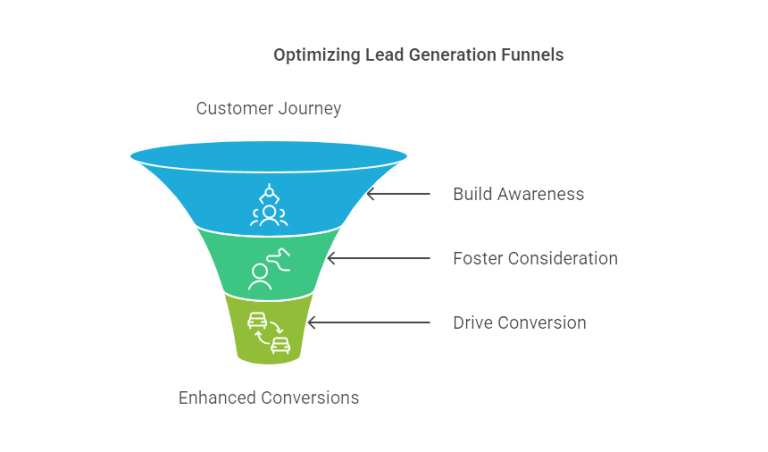
Stage 1 – TOFU: Build Awareness and Capture Attention
At the top of your funnel, you’re not selling, you’re earning attention. The goal is simple: make the right people stop scrolling, notice you, and get curious enough to learn more.
Think of TOFU as pattern interruption with purpose. Your audience doesn’t know you yet, so your job isn’t to convince, it’s to connect. Curiosity is the currency here.
🎯 Core Objective:
Attract the right audience and spark interest by aligning your message with their existing problems, goals, or beliefs.
Proven TOFU Strategies for 2025
1. SEO-Driven Content That Matches Intent
Create blog posts and guides that directly answer what your audience is already searching for. Focus on long-tail, intent-based keywords like “best lead generation software for agencies” or “how to automate client acquisition.”
Each post should lead naturally to your next step: a lead magnet, email signup, or demo.
2. Scroll-Stopping Social Ads
Your first line and first second decide everything. Use bold visuals, surprising stats, or contrarian hooks that make your audience pause. Pair this with copy that transitions quickly from intrigue to value (“Here’s why your funnel isn’t converting and how to fix it”).
3. High-Value Lead Magnets
Most free resources are forgettable. Instead, offer something instantly usable checklists, calculators, templates, or swipe files. The faster your prospect gets a “win,” the more likely they’ll continue engaging with your brand.
4. Short-Form Video Education
Reels, TikToks, and YouTube Shorts are your top-of-funnel accelerators. Share one specific insight per video, something that solves a micro-problem or challenges a common misconception. Hook hard in the first 3 seconds, deliver value fast, and end with a soft CTA.
Example: TOFU in Action
Imagine you run a digital marketing agency. Instead of a vague “We help businesses grow,” you offer a “7-Point Funnel Audit Checklist That Added $23K in 3 Weeks.”
You promote it with a short video ad showing the before-and-after results. Clear outcome. Fast proof. Immediate intrigue.
That’s TOFU done right, attention meets alignment.
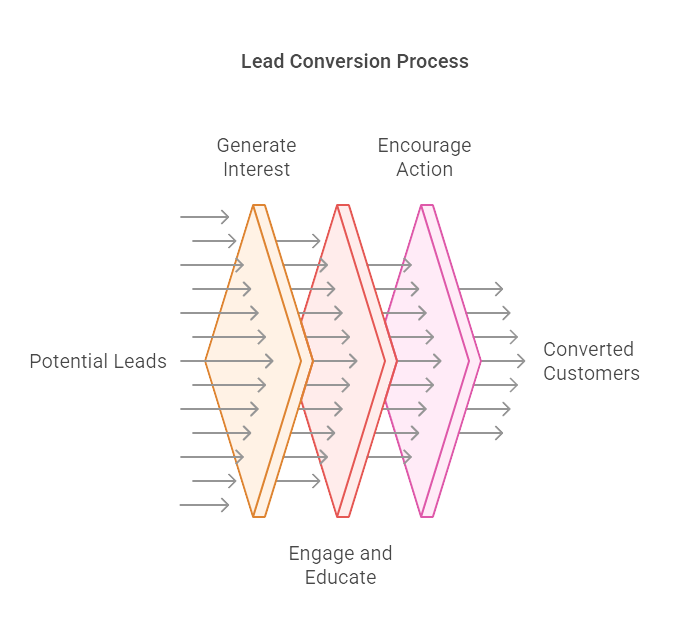
Stage 2 – MOFU: Nurture Leads and Build Unshakable Trust
Once someone opts in, they’re curious, not convinced.
This is where the Middle of Funnel (MOFU) does the heavy lifting: turning attention into trust, and trust into readiness to buy.
At this stage, your job is to educate, reassure, and pre-sell.
You’re not pitching; you’re proving that you understand your audience better than anyone else.
Done right, MOFU is where your leads stop seeing you as “just another marketer” and start seeing you as the obvious solution.
Proven MOFU Strategies That Convert Skeptics into Buyers
1. Automated Nurture Sequences That Teach and Lead
Drip campaigns remain your highest-ROI asset. Use 3–7 emails to educate, share small wins, and answer unspoken objections.
Each message should build momentum toward your offer without overselling.
Tip: Combine logic (case studies, data) with empathy (pain points, transformation stories).
2. Webinars, Workshops, or Live Demos
Nothing builds trust faster than showing your process live. Whether it’s a live Q&A or an evergreen replay, a great webinar demonstrates expertise while pre-selling your offer naturally.
Use it to reframe misconceptions and showcase your authority.
3. Retargeting Ads That Reinforce Trust
Now that your leads know you, follow up with social proof and proof of results. Show testimonials, client success videos, or “behind the scenes” case studies.
These reminders keep your brand top of mind while quietly answering objections.
4. Interactive or Comparison-Based Content
Tools like calculators, quizzes, or “this vs. that” comparison guides work because they make the lead participate.
When someone interacts with your content, they start convincing themselves. Engagement equals investment.
Example: How a Simple MOFU System Builds Trust Fast
Scenario: You’ve captured a lead with your free “Funnel Audit Checklist.”
Here’s a simple 5-day MOFU flow that warms them up:
- Day 1: Email — “The #1 mistake people make after using this checklist.”
- Day 3: Case study — “How one client added 12 qualified calls in a week.”
- Day 4: Retargeting ad — “Watch how this system works in 60 seconds.”
- Day 5: Webinar invite — “Live teardown: how to turn a funnel from 3% to 38% conversion.”
By the end of the week, your lead has context, confidence, and curiosity the perfect setup for your offer.
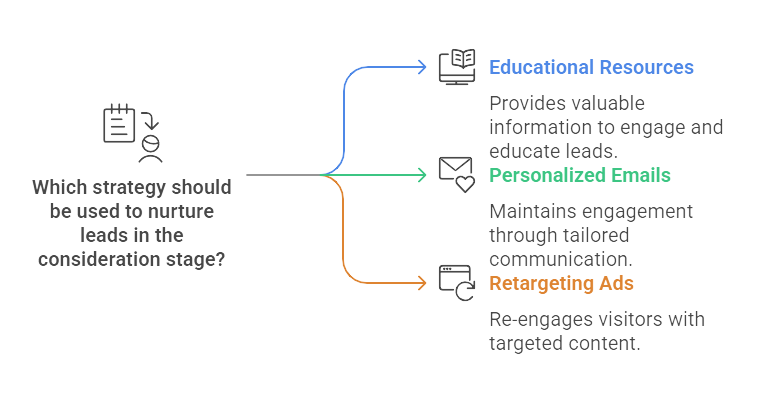
Stage 3 – BOFU: Convert Like a Closer
This is where leads stop browsing and start buying. The Bottom of Funnel (BOFU) is your conversion engine where attention turns into action and trust becomes revenue.
At this stage, your only goal is to make the next step obvious and irresistible.
Your audience already knows the problem. They’re evaluating you against every other option.
So clarity, proof, and urgency aren’t optional, they’re everything.
Proven BOFU Strategies That Turn Interest into Sales
1. Landing Pages That Sell Without Friction
Every BOFU page should have one goal: conversion. Strip away distractions, focus on benefits, and end with a single call to action.
Use visuals, testimonials, and concise copy to reinforce why taking action now makes sense.
Pro Tip: Place your strongest testimonial or result within the first scroll. Most readers won’t make it to the bottom.
2. Urgency & Scarcity That Feels Real
People procrastinate by default, your job is to make delay feel costly.
Use real, time-bound offers (e.g., bonuses expiring in 48 hours or limited seats for a call). Avoid fake countdown timers; authenticity drives more action than gimmicks.
3. Social Proof That Removes Doubt
At BOFU, skepticism is your biggest competitor. Combat it with authentic proof: customer videos, screenshots, and before-and-after transformations.
Show, don’t tell. Let your results do the convincing.
4. Personalized Conversion Events
For high-ticket or service-based offers, nothing closes like a conversation.
Offer strategy calls, demos, or live audits that diagnose the lead’s problem and prescribe your solution fast.
These aren’t sales calls; they’re clarity calls that turn “I’ll think about it” into “When can we start?”
Example: How BOFU Converts Cold Leads into Paying Clients
Let’s say you’ve been nurturing a lead through your funnel. They’ve engaged with your content, attended your webinar, and opened every email.
Here’s how a well-built BOFU move sequence might look:
- Day 1: Personalized email → “Here’s how [client name] got results using this exact system.”
- Day 2: Retargeting ad → Testimonial clip with a call-to-action: “Start your 14-day trial.”
- Day 3: Follow-up → “Bonus strategy call expires Friday reserve your spot.”
By this point, they’ve seen the proof, felt the value, and know the deadline. The only logical move left is action.
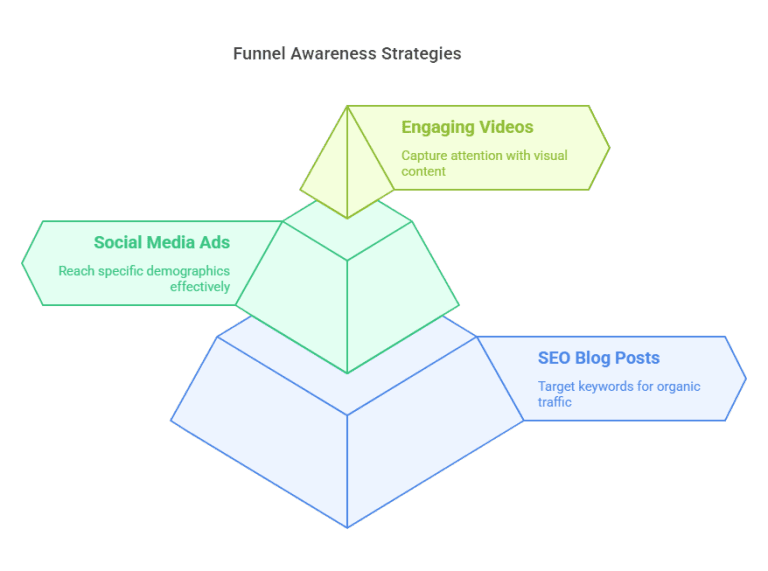
How to Build a Lead Generation Funnel (Step-by-Step)
Knowing the theory is one thing, building a funnel that actually converts is another.
Most businesses throw together a landing page and call it a funnel. Then they wonder why nothing sticks.
A real lead generation funnel is built with purpose, precision, and testing.
Follow these six steps to create a system that consistently attracts, nurtures, and converts leads without guesswork.
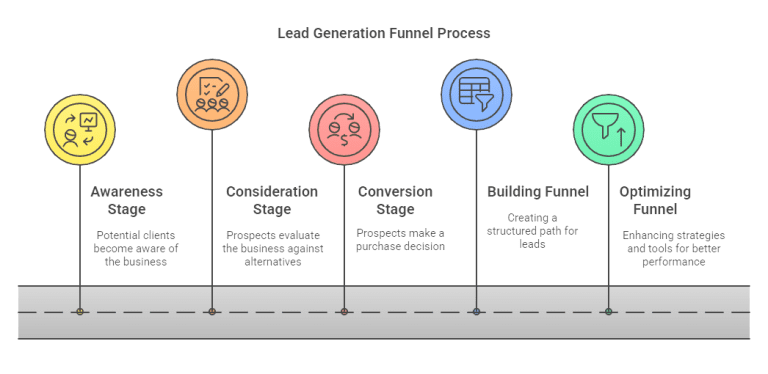
Step 1: Identify Your Ideal Customer
Forget broad “target markets.” You’re speaking to one person, the one who’s already searching for what you offer.
Define their pain points, desires, and objections. Understand their language and what triggers trust.
Tools to Use:
- Google Analytics & Meta Audience Insights uncover real behavior and demographics.
- Surveys & Live Chat capture insights straight from your audience.
- HubSpot or Notion Templates document personas and refine over time.
Pro Tip: Ask this question: What problem does my offer solve better, faster, or differently than anyone else?
Step 2: Map the Funnel Journey
Before you create anything, visualize the full path from first click to conversion.
A great funnel feels intentional because every step connects naturally to the next.
Use a visual planner like Funnelytics or Lucidchart to map:
- Entry points (ads, blogs, SEO, social content)
- Lead magnet offer (checklist, webinar, quiz)
- Nurture sequence (emails or retargeting ads)
- Conversion offer (sales page, booking link, free trial)
- Follow-ups and retention flow
Goal: Make the journey seamless. If your funnel feels logical, your audience will move through it effortlessly.
Step 3: Create Content for Every Stage
Each funnel stage has a purpose: don’t mix them up.
- TOFU (Top): Spark curiosity with blogs, reels, or lead magnets.
- MOFU (Middle): Educate through webinars, email series, or case studies.
- BOFU (Bottom): Convert using testimonials, demos, and personalized offers.
Tip: Every piece of content should solve one problem and set up the next step. Clarity beats cleverness every time.
Step 4: Drive Targeted Traffic
A funnel without traffic is just a diagram. Focus on quality over quantity 500 qualified clicks will always outperform 5,000 random ones.
- TOFU: SEO blogs, YouTube videos, and social ads.
- MOFU: Retargeting and email follow-ups.
- BOFU: Direct-response ads or outreach with a clear offer.
Tip: Make sure your message matches your traffic source. The promise in your ad should align perfectly with your landing page.
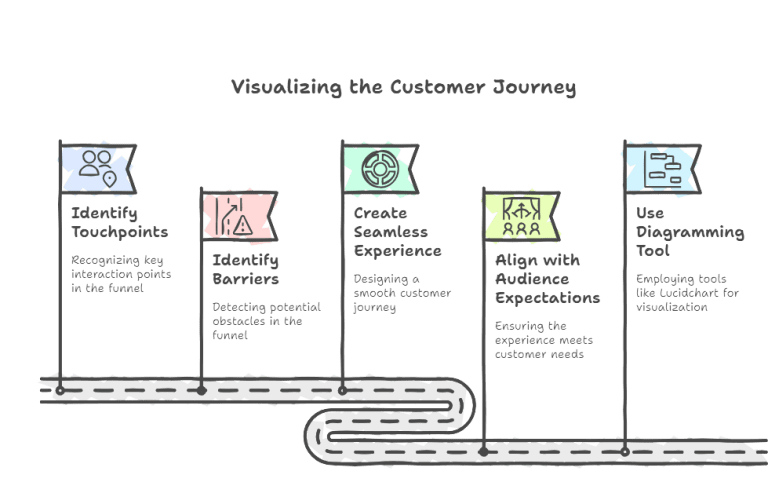
Step 5: Automate Smartly
Automation turns your funnel into a 24/7 sales engine.
Set up triggers that respond to user behavior automatically, no manual follow-ups needed.
Automation Tools:
- Email: GetResponse, ActiveCampaign
- Workflows: Zapier, Make
- CRM: Pipedrive, HubSpot
- Retargeting: Meta Pixel, Google Tag Manager
Pro Tip: Start small. Automate only what’s proven to work manually first then scale automation for consistency.
Step 6: Test, Optimize, and Scale
Your first funnel is a draft, treat it like a living system. Use data, not instinct, to guide your decisions.
Test one variable at a time:
- Headlines
- CTAs
- Offer angles
- Email subject lines
- Ad creative
Then double down on what converts and cut what doesn’t.
Pro Tip: Document every test and outcome. Small tweaks compound into massive gains over time.
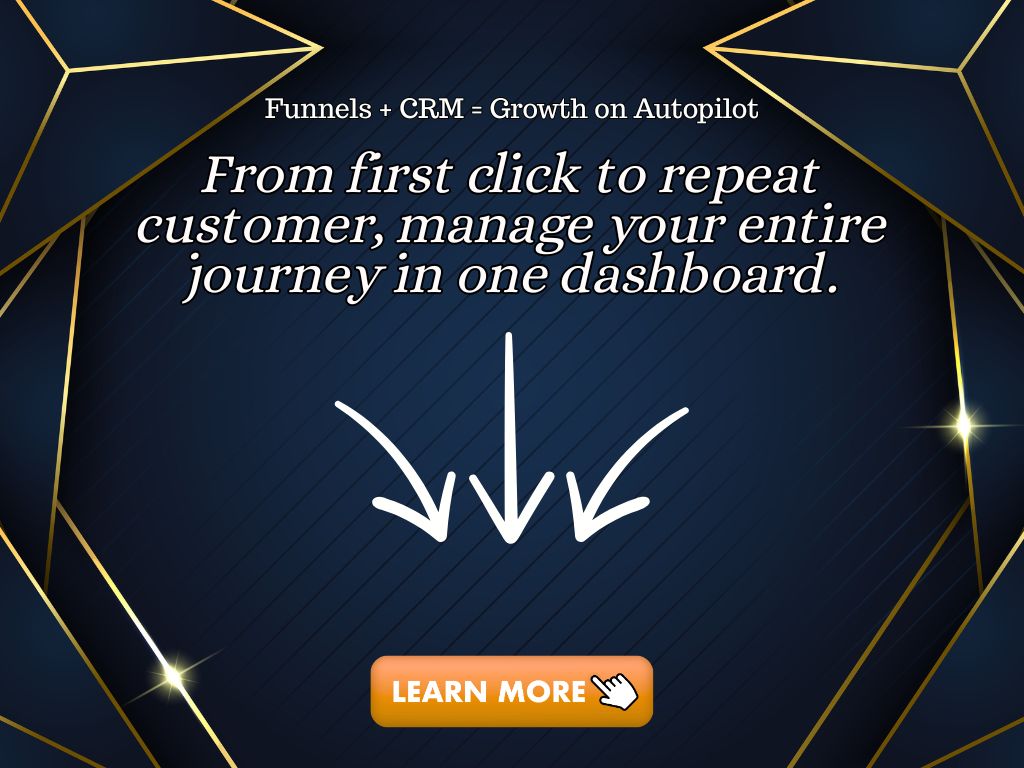
⚙️ Lead Generation Funnel: The Optimization Toolbox (By Stage)
Your funnel is only as strong as the tools behind it. The right stack doesn’t just make things easier, it multiplies your efficiency, consistency, and results.
But here’s where most marketers go wrong: They either use too many tools (creating chaos) or the wrong tools for the wrong stage (creating bottlenecks).
Below is your no-fluff toolbox organized by funnel stage, so you only focus on what truly moves the needle.
🧠 TOFU (Top of Funnel) – Attract & Capture Attention
Goal: Get noticed. Drive clicks. Earn opt-ins.
At this stage, you’re turning strangers into potential leads — so visibility, clarity, and relevance matter most.
| Purpose | Tool | Why It Works |
|---|---|---|
| SEO & Keyword Research | Ahrefs / SEMrush | Find what your audience is searching for and create content that ranks fast. |
| Creative Design | Canva / Visme | Build lead magnets, ads, and visuals that stand out on crowded feeds. |
| Traffic Generation | Google Ads / Meta Ads Manager | Run targeted ad campaigns to attract the right audience efficiently. |
| Lead Capture | Typeform / Jotform | Create interactive quizzes and forms that convert passive browsers into active subscribers. |
🎯 Pro Tip: Focus on intent, not impressions. A smaller, high-intent audience will always outperform a broad reach.
💡 MOFU (Middle of Funnel) – Nurture & Build Trust
Goal: Build relationships. Turn attention into belief.
At this stage, your audience knows you exist — now they need to trust that you can solve their problem.
| Purpose | Tool | Why It Works |
|---|---|---|
| Landing Page Builder | ClickFunnels / Leadpages | Build optimized pages that guide visitors toward your lead magnet or next offer. |
| Email Automation | ActiveCampaign / GetResponse | Send tailored email sequences that educate and nurture based on behavior. |
| Live & Evergreen Webinars | WebinarJam / Demio | Host workshops that showcase expertise and move leads closer to buying. |
| Resource Delivery | Loom / Notion / Google Docs | Deliver mini-guides, templates, or resources that demonstrate value upfront. |
🔥 Pro Tip: Every interaction at this stage should educate, reassure, and pre-frame your offer — not push it.
💰 BOFU (Bottom of Funnel) – Convert & Close
Goal: Seal the deal. Turn interest into action.
At this point, the lead is informed and considering a decision — your job is to make that “yes” frictionless.
| Purpose | Tool | Why It Works |
|---|---|---|
| Conversion-Optimized Pages | Unbounce / Instapage | Create A/B tested pages that maximize your final conversion rate. |
| Appointment Booking | Calendly / SavvyCal | Make it effortless to book demos, consultations, or calls. |
| CRM & Deal Tracking | HubSpot / Pipedrive | Track leads, automate follow-ups, and never lose a hot prospect. |
| Personalized Video Sales | Bonjoro / VideoAsk | Add human touch at scale with personalized video messages that boost response rates. |
💬 Pro Tip: At BOFU, clarity beats cleverness — remove distractions, simplify the offer, and make taking action the easiest choice possible.
⚡ Recommended Funnel Stack (Start-to-Finish)
Here’s a simple, battle-tested setup that works for 90% of businesses:
| Funnel Stage | Recommended Tool | Function |
|---|---|---|
| Lead Magnet Creation | Canva | Design lead magnets and ad creatives. |
| Traffic | Meta Ads / Google Ads | Drive targeted visitors. |
| Landing Page | ClickFunnels | Capture leads efficiently. |
| Nurture & Email | GetResponse | Automate and personalize follow-ups. |
| Booking & CRM | Calendly + HubSpot | Convert leads into calls and track every touchpoint. |
Once this system is running, your funnel works 24/7 — attracting, nurturing, and closing clients while you focus on growth.
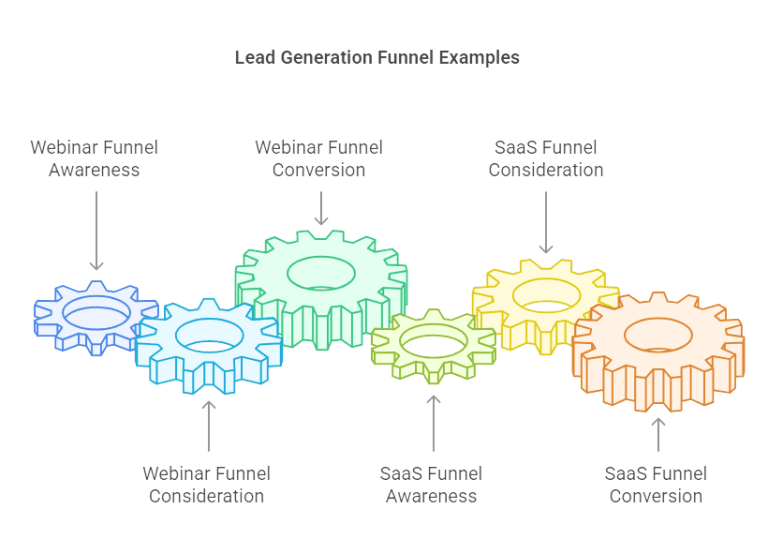
Lead Generation Funnel: Metrics That Actually Matter
Most marketers are drowning in data but starving for insight. They obsess over vanity metrics like likes, impressions, and traffic, while the real numbers that determine profitability slip through the cracks.
If you want to scale with precision, you need to track what actually reflects conversion health, the metrics that show where leads drop off, when trust builds, and why customers finally buy.
Below is a breakdown of the only metrics that truly matter, organized by funnel stage.
🧠 TOFU (Top of Funnel): Measure Attention & Efficiency
Goal: Understand if your marketing is reaching, engaging, and converting the right people.
| Metric | Why It Matters | Target Benchmark |
|---|---|---|
| Click-Through Rate (CTR) | Measures how well your ad or content grabs attention and compels action. | 2–5% for ads, 3–8% for organic posts |
| Cost per Lead (CPL) | Shows how efficiently you’re capturing leads — the lower, the better (without losing quality). | Varies by niche; aim for sustainable ROI |
| Landing Page Conversion Rate | Reveals how persuasive your page is at converting visitors into subscribers or leads. | 20–40% is strong depending on traffic quality |
🧩 Pro Tip: Track traffic quality alongside CPL — cheap leads mean nothing if they don’t convert later.
💡 MOFU (Middle of Funnel): Measure Trust & Engagement
Goal: Evaluate how well you’re nurturing relationships and moving leads closer to buying.
| Metric | Why It Matters | Target Benchmark |
|---|---|---|
| Email Open Rate | Gauges if your subject lines and timing are effective. | 25–40% average |
| Click Rate (Within Emails) | Measures engagement with your content — are they curious or tuning out? | 3–8% average |
| Lead Magnet Engagement Rate | Tells you if your content delivers real value — did they download, watch, or use it? | 50%+ engagement ideal |
🔥 Pro Tip: Watch for drop-offs between email 2 and 4 in your nurture sequence — that’s where cold leads often disengage.
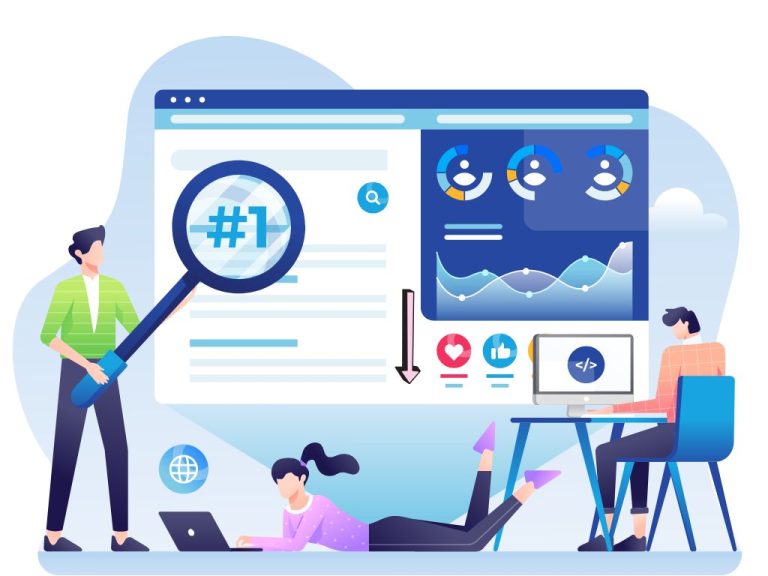
💰 BOFU (Bottom of Funnel): Measure Conversion & ROI
Goal: Quantify how efficiently your funnel turns trust into revenue.
| Metric | Why It Matters | Target Benchmark |
|---|---|---|
| Conversion Rate (Final Offer) | Core indicator of funnel success — the % of leads who buy or book. | 2–10% depending on offer type |
| Sales Call Show-Up Rate | Reveals how well you’re qualifying leads and confirming intent. | 70–90% for warm leads |
| Customer Acquisition Cost (CAC) | Tells you how much it costs to acquire one paying customer. | Should stay below ⅓ of customer lifetime value (CLV) |
💬 Pro Tip: Combine CAC with Lead-to-Customer Rate — together, they tell you how sustainable your funnel really is.
🧩 Summary: Funnel Metrics That Drive Growth
| Funnel Stage | Focus Metric | Core Insight |
|---|---|---|
| TOFU | CTR, CPL, Conversion Rate | Are your ads and landing pages attracting quality leads efficiently? |
| MOFU | Email Open & Click Rate, Engagement | Are your nurture systems building trust and keeping leads engaged? |
| BOFU | Conversion Rate, CAC, LTV | Is your funnel converting profitably and sustaining long-term ROI? |
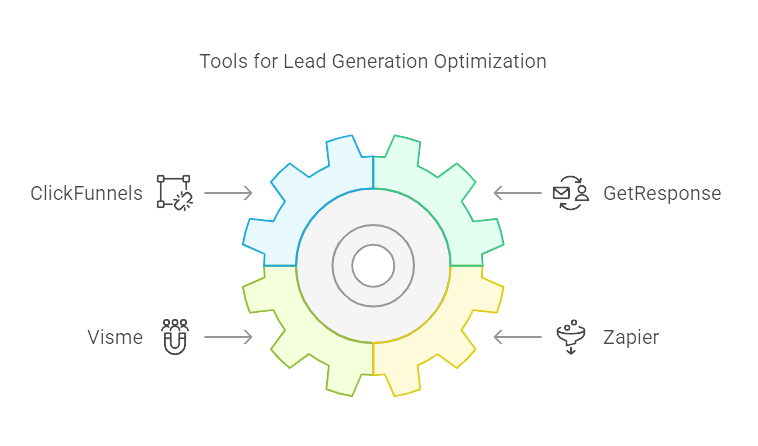
Maximize Your Leads and Earnings Without Extra Work
- Create, store, and track lead magnets effortlessly, all from one simple dashboard.
- AI-powered templates help you generate high-converting lead magnets in minutes.
- Boost commissions with built-in branding that turns every lead magnet into a traffic source.

Lead Generation Funnel Templates That Work (And Why They Convert)
Most businesses overcomplicate funnel design and it kills their conversions.
The truth? You don’t need 10 stages, 6 automations, and a PhD in marketing tech.
You need a proven funnel framework that’s already validated across industries and a clear understanding of when to use each one.
Below are four battle-tested lead generation funnel templates that consistently convert in 2025. Each one is simple to build, easy to adapt, and engineered to move cold traffic to paying clients fast.
1. The Webinar Funnel (High-Trust Selling for Coaches, Courses & SaaS)
Best For: Coaches, consultants, and SaaS companies selling mid to high-ticket offers ($500–$5K+).
Goal: Build authority and convert leads through education.
Funnel Flow:
- TOFU: Run targeted ads or publish short-form video teasers promoting your upcoming training or masterclass.
- MOFU: Deliver an engaging webinar packed with actionable value not fluff. Include proof, case studies, and quick wins.
- BOFU: Present a time-limited offer or free strategy call immediately after the webinar (or in a 48-hour replay window).
Pro Tip: Add automated follow-up emails for replay reminders, FAQs, and testimonials to drive urgency and trust.
Example Headline:
“How We Tripled Lead Conversions in 30 Days Without Increasing Ad Spend (Free 45-Minute Masterclass)”
2. The SaaS Funnel (Prove Value, Fast)
Best For: Software and digital platforms.
Goal: Get users into a free trial or demo that showcases ROI instantly.
Funnel Flow:
- TOFU: Use SEO content or paid search ads (“Best tools for [problem]”) to attract high-intent visitors.
- MOFU: Offer a case study or mini demo that highlights measurable results (e.g., “How [User] Cut Costs by 40% Using [Tool]”).
- BOFU: Drive to a free trial, demo booking, or limited-time onboarding bonus.
Pro Tip: Add an in-page live chat or “watch demo now” CTA to remove friction and catch hesitations in real time.
Example Headline:
“Try [Software Name] Free for 14 Days + Get Done-for-You Setup and Training (Expires Friday)”
3. The E-Commerce Funnel (Show, Prove, Convert)
Best For: Product-based businesses, eCommerce stores, or dropshipping brands.
Goal: Turn discovery into impulse-driven sales.
Funnel Flow:
- TOFU: Create product demo videos or UGC ads that highlight transformation (before/after, problem/solution).
- MOFU: Retarget visitors with reviews, social proof, and limited bundles (e.g., “Buy 2, Get 1 Free”).
- BOFU: Close with urgency offer an exclusive discount, bonus gift, or limited-time shipping perk.
Pro Tip: Use post-purchase funnels to upsell, cross-sell, or invite to loyalty programs.
Example Headline:
“Transform Your Skincare in 7 Days 20% Off Ends Tonight”
4. The Lead Magnet Funnel (Universal & Evergreen)
Best For: Any business building an audience or nurturing long-term leads.
Goal: Capture emails, nurture trust, and convert with low friction.
Funnel Flow:
- TOFU: Offer a free, high-value resource checklist, cheat sheet, or calculator in exchange for an email.
- MOFU: Send a 3–5 email sequence that educates and overdelivers before pitching.
- BOFU: Offer a small “gateway product” or free consultation that transitions into your core offer.
Pro Tip: A/B test your lead magnet titles. Small tweaks in phrasing can double opt-ins.
Example Headline:
“Free Funnel Audit Checklist: 7 Fixes That Add $10K in 3 Weeks”
⚙️ Choosing the Right Funnel for Your Business
| Funnel Type | Best For | Conversion Focus | Complexity | Average ROI |
|---|---|---|---|---|
| Webinar Funnel | Coaches / SaaS | Authority + Trust | Medium | High |
| SaaS Funnel | Software / Digital Tools | Product Experience | Medium | High |
| E-Commerce Funnel | Physical Products | Urgency + Social Proof | Low | Medium |
| Lead Magnet Funnel | All Businesses | List Building + Nurture | Low | Long-Term |
💡 Tip: Simplify first, scale later. Start with one funnel, perfect it, then duplicate what works. Complexity kills momentum — consistency compounds conversions.
🚫 Common Mistakes to Avoid in Lead Generation Funnels
Even a great offer can flop if your funnel is built wrong. These are the mistakes that silently drain conversions — and how to fix them fast.
| Mistake | Why It Hurts | Smart Fix |
|---|---|---|
| Selling Too Early | Cold leads don’t trust you yet — they tune out or bounce. | Warm them first with value-driven content and automated nurture emails before making an offer. |
| One-Size-Fits-All Funnel | Treating every lead the same kills personalization and relevance. | Segment leads by source, behavior, or intent so your messaging fits their stage. |
| Ignoring Metrics | You can’t improve what you don’t measure — leaks stay hidden. | Track CTR, conversion rates, and cost per lead weekly. Adjust based on real data. |
| Overcomplicating the Funnel | Too many steps create friction and drop-offs. | Simplify. Each stage should have one clear goal and one CTA. |
| Tracking Vanity Metrics | Likes and impressions don’t equal revenue. | Focus on KPIs tied to sales — conversion rate, CAC, LTV, and revenue per lead. |
| Skipping Follow-Up Automation | Leads forget you exist after one touchpoint. | Automate 3–5 follow-up emails and retargeting ads to stay top-of-mind. |
| Weak or Generic Offers | “Free consultation” doesn’t stand out anymore. | Craft specific, outcome-driven offers that solve a pain point clearly. |
💡 Bottom Line: A clean, focused funnel always beats a flashy, complicated one. Audit your funnel quarterly, track what’s working, and fix one bottleneck at a time — improvement is a process, not a one-time task.
Conclusion: Build a Funnel That Works While You Sleep
Most businesses don’t fail because of bad offers, they fail because their funnels never give those offers a chance to be seen.
A well-optimized Lead Generation Funnel changes that completely. It attracts attention, nurtures trust, and converts curiosity into commitment automatically.
Your funnel becomes the silent engine behind your growth generating leads, booking calls, and driving sales even when you’re not online.
That’s the power of a system that works for you, not the other way around.
Here’s your next move:
- Build it — Start with one clear funnel designed around a single goal.
- Test it — Track every metric that matters and spot leaks early.
- Refine it — Use data, feedback, and automation to improve results over time.
Because in 2025 and beyond, the businesses that dominate aren’t the loudest; they’re the ones with the most predictable systems.
Once your funnel is built, traffic becomes an opportunity, not a gamble. You’ll stop chasing leads and start attracting them consistently.
The best funnel doesn’t just make sales; it builds momentum.
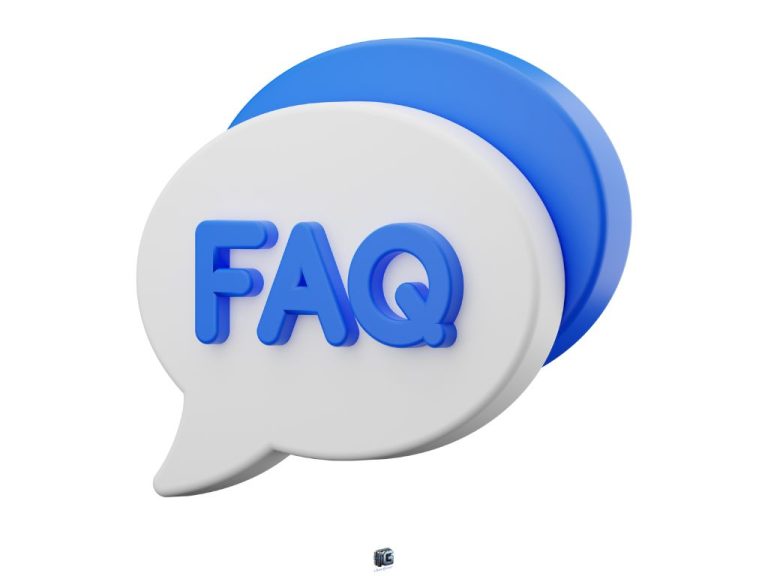
FAQs About Lead Generation Funnel
What is a lead generation funnel?
A lead generation funnel is a structured system that guides prospects from first contact to conversion. It combines pages, emails, and automation to attract leads, nurture trust, and turn interest into sales all while tracking performance at each stage.
How is a funnel different from a regular landing page?
A landing page captures attention once. A funnel captures attention, builds trust, and follows up automatically.
It’s a complete journey from awareness to action designed to convert at every step, not just collect an email.
What tools do I need to build a lead generation funnel?
It depends on your business model:
- Coaches / Consultants: Webinar or application funnels
- SaaS / Digital Products: Free trial or demo funnels
- E-commerce / Brands: Discount or quiz-based funnels
- General Businesses: Lead magnet funnel (guides, checklists, templates)
The best funnel is the one that matches your customer’s intent and your offer’s value.
How long does it take to build a funnel that works?
You can build a simple lead generation funnel in a few hours using tools like Systeme.io, ClickFunnels, or Leadpages.
Expect 1–2 weeks to fully optimize it, testing copy, visuals, and emails before seeing consistent conversions.
What tools do I need to build a lead generation funnel?
You’ll need:
- Page builder: ClickFunnels, Leadpages, or Unbounce
- Email automation: GetResponse, ActiveCampaign, or ConvertKit
- Analytics / tracking: Google Analytics, Funnelytics, or Hotjar. Optional add-ons include chat widgets, CRM tools, and retargeting pixels for advanced tracking.
How do I know if my funnel is working?
Monitor your conversion metrics:
- Click-through rate (CTR)
- Cost per lead (CPL)
- Email open and click rates
- Sales or call booking rate
If these improve week over week, your funnel is moving in the right direction. If not, it’s time to test and tweak.
Do I need a large budget to run a funnel?
Not necessarily. You can start free or low-cost using tools like Systeme.io or MailerLite. What matters most is clarity and consistency, not how much you spend. Focus on message-market fit before scaling with paid ads.
How do I increase my lead-to-client conversion rate?
- Use strong proof (case studies, testimonials, data).
- Offer clear next steps (calls, demos, or trials).
- Follow up with behavior-based automation leads convert best when messages feel personal and timely. Conversion is about precision, not pressure.
Should I build one funnel or multiple funnels?
Start with one well-optimized funnel for your main offer. Once it consistently converts, expand into additional funnels (upsells, evergreen webinars, or niche lead magnets). Simplicity scales faster than complexity.
What’s the biggest mistake people make with funnels?
They treat it as a one-time setup. A funnel is a living system, it needs data, testing, and refinement. The businesses that win are the ones that measure, learn, and improve every single week.
Launch Your Funnel & Scale Faster Than Ever!
Build, launch, and grow without the tech headaches.
- Drag-and-drop funnel builder
- High-converting templates
- Built-in automation & analytics

3 Comments
Best Lead Generation Tools for 2025 (Free & Paid) - Ismel Guerrero. · February 10, 2025 at 9:28 pm
[…] If you’re looking to build and optimize a high-converting lead generation funnel, check out our detailed guide on lead generation funnels. […]
Lead Generation Funnels: Best Strategies for Sales & Marketing - Ismel Guerrero. · February 13, 2025 at 10:33 pm
[…] For more insights on funnel building, check out our Lead Generation Funnel Guide. […]
Marketing Funnel: Stages, Strategies, and Examples - Ismel Guerrero. · February 23, 2025 at 8:30 am
[…] To dive deeper into funnel optimization, check out our Lead Generation Funnel Guide. […]